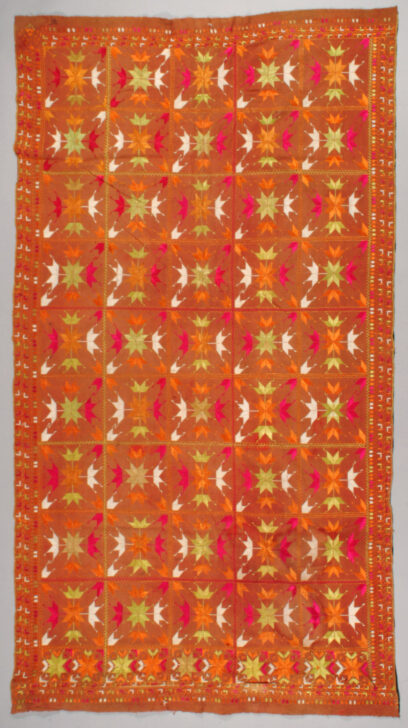Phulkari Shawl with Stylized Bagh Tara (four-part flower) Designs
Indian

Description
Gallery Rotation Spring/Summer 2012
Phulkari with stylized bagh tara (four-part flower) designs
India, Eastern Punjab
First half of 20th century
Homespun cotton cloth with silk embroidery
Anonymous gift in honor of Karuna and Brijen Goswamy, 2005/2.11
The Punjab region is known for these brilliant embroideries that can function as head coverings, wall hangings, or dresses. The name phulkari, meaning “flower working,” was given to them for their beautiful and intricate embroidered designs. A folk art handed down among women for generations, young girls would begin learning phulkari from their mothers, often participating in village stitching circles. Phulkari are embroidered with stylized designs of motifs like flowers and birds with ample space left between them to allow vibrant patches of the base fabric to show through. This fabric is commonly brick red, an auspicious color associated with shakti (power) and the mother goddess.
For a momentous occasion like a wedding, the entire surface of the phulkari would be covered with embroidery. This type of phulkari is called a bagh. From the time a young girl begins to learn phulkari, she hones her skills and works towards creating her wedding bagh, and it is said that she stitches into it her hopes and dreams for marriage. Though the tradition of phulkari embroidery nearly disappeared in the late twentieth century, the designs have recently become an international fashion trend.
Subject Matter:
The Punjab region is known for these brilliant embroideries that can function as head coverings, wall hangings, or dresses. The name phulkari, meaning “flower working,” was given to them for their beautiful and intricate embroidered designs. A folk art handed down among women for generations, young girls would begin learning phulkari from their mothers, often participating in village stitching circles. Phulkari are embroidered with stylized designs of motifs like flowers and birds with ample space left between them to allow vibrant patches of the base fabric to show through. This is commonly brick red, an auspicious color associated with shakti (power) and the mother goddess. For a momentous occasion like a wedding, the entire surface of the phulkari would be covered with embroidery. This type of phulkari is called a bagh. From the time a young girl begins to learn phulkari, she hones her skills and works towards creating her wedding bagh, and it is said that she stitches into it her hopes and dreams for marriage. Though the tradition of phulkari embroidery nearly disappeared in the late twentieth century, the designs have recently become an international fashion trend.
Physical Description:
Embroidery on a plain cotton fabric (khaddar). Red-orange khaddar with neon orange, green, white and red accents which make up the bagh tara (four-part flower) design.
Usage Rights:
If you are interested in using an image for a publication, please visit https://umma.umich.edu/request-image/ for more information and to fill out the online Image Rights and Reproductions Request Form.